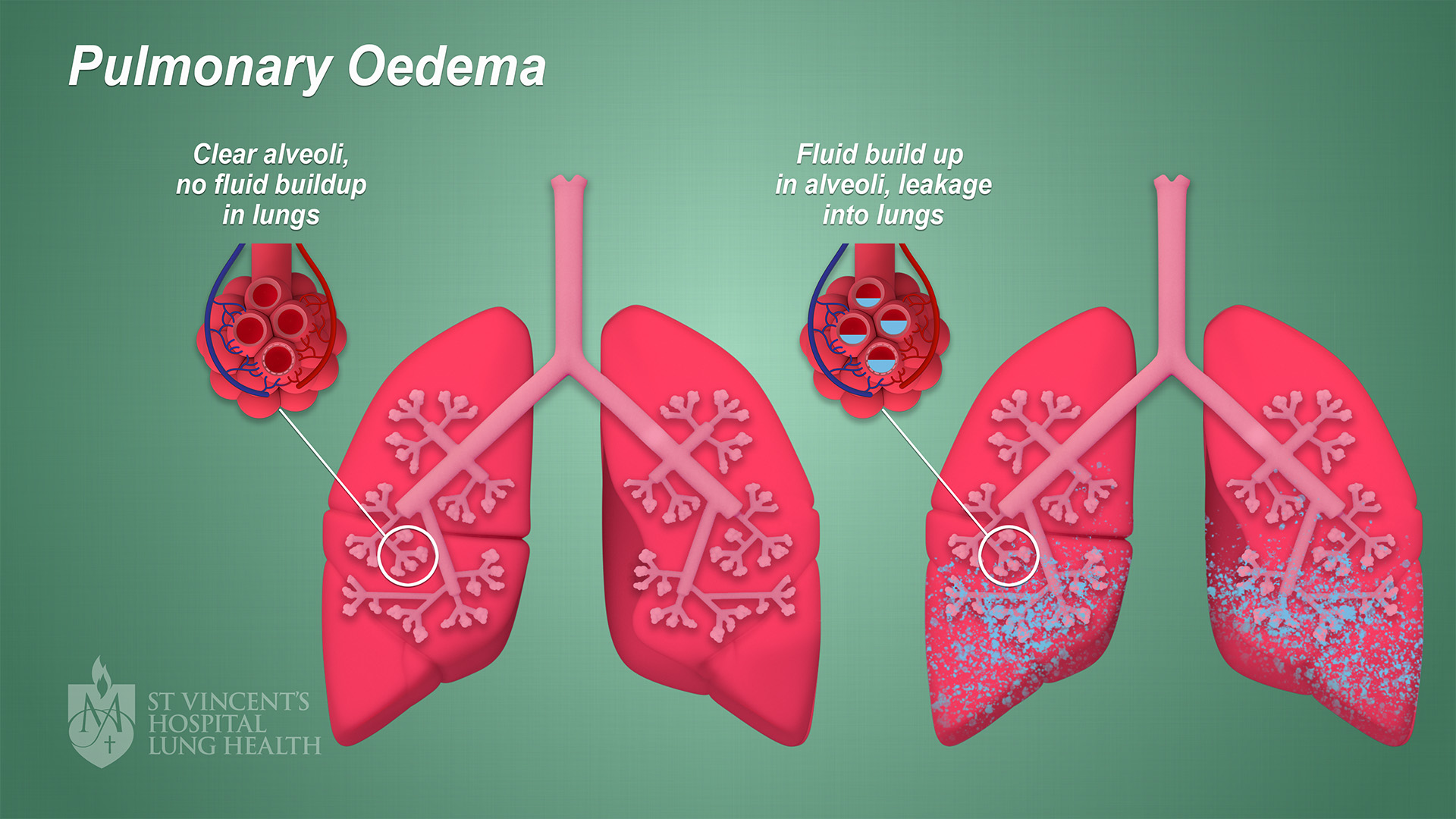Pulmonary Oedema
Pulmonary oedema is a buildup of fluid in your lungs.
What is pulmonary oedema?
What are the causes of pulmonary oedema?
What are the signs and symptoms of pulmonary oedema?
What are the possible tests to diagnose pulmonary oedema?
What are the possible procedures and treatments for pulmonary oedema?
What is the future plan if you have had pulmonary oedema?
What is pulmonary oedema?
Pulmonary oedema is a buildup of fluid in the lungs. People who have pulmonary oedema are unable to breathe properly because fluid fills their air sacs (alveoli). As a result, oxygen does not get into the blood and the body can’t get rid of carbon dioxide.
Pulmonary oedema that comes on suddenly is a medical emergency.
The image below demonstrates pulmonary oedema. (Click image to enlarge)

What are the causes of pulmonary oedema?
Pulmonary oedema can be caused by:
- Chemical exposure
- Drug overdoses or adverse reactions
- Exercising at high altitudes
- Heart problems – if the heart is not able to pump blood, fluid can flow back into the lungs
- Lung diseases or infections – fluid can leak into the lungs when they are inflamed
- Near drowning
- Nervous system conditions
- Organ failure
- Pulmonary embolism
- Smoke inhalation.
What are the signs and symptoms of pulmonary oedema?
Pulmonary oedema that comes on suddenly is a medical emergency. If you have any of the following symptoms and suspect you may have pulmonary oedema, call 000:
- Dizziness
- Feeling weak or lightheaded
- Grayish or blue skin
- Shortness of breath
- Trouble breathing
- Wheezing or gasping.
Pulmonary oedema can also be chronic and come on gradually. This form of pulmonary oedema is less serious and symptoms may include:
- Rapid weight gain, which can signal fluid buildup or heart failure
- Swollen feet and legs
- Tiredness
- Trouble breathing when lying down
- Waking at night feeling breathless
- Wheezing.
What are the possible tests to diagnose pulmonary oedema?
If you have symptoms of pulmonary oedema, your doctor will look for:
- Abnormal sounds coming from your heart and lungs
- Blue or grayish-coloured skin
- Signs of fluid in the lungs
- Signs of swelling in the legs and abdomen.
You might need additional tests to diagnose your symptoms. The following tests can help to diagnose pulmonary oedema:
- Blood tests – various blood tests can identify causes of your pulmonary oedema and check the levels of oxygen and carbon dioxide your blood
- Chest X-ray – an X-ray scan to look for fluid in the lungs
- Coronary angiogram – to check your heart’s function and identify any issues that may be causing pulmonary oedema
- Echocardiogram – to check your heart’s function and look for poor blood flow
- Electrocardiogram (ECG) – to check your heart’s function and rhythm
- Pulse oximetry – a sensor attached to your finger or ear to check the level of oxygen in your blood.
What are the possible procedures and treatments for pulmonary oedema?
If your pulmonary oedema is a medical emergency, your medical team will give you oxygen and identify the cause of your condition. You will also be given medication to help manage your symptoms while your body recovers.
What is the future plan if you have had pulmonary oedema?
If you might be at risk of developing pulmonary oedema or have had it already, you’ll need to focus on maintaining a healthy lifestyle. Get regular vaccinations, take your prescribed medications, and talk to your doctor about preventative strategies.
Quitting smoking, eating a healthy diet, maintaining a healthy weight, getting regular exercise, and controlling your blood pressure are essential steps for you to take. If you have had pulmonary oedema due to a known cause, such as high altitude exercise or drug taking, avoid these activities.
Speak to your doctor if you are worried you may be at risk of pulmonary oedema.